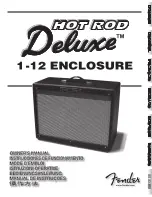
9
A WORD ON COUNTERSINKS
The overall success of this project depends somewhat on your ability to accurately countersink the
wood screws, so that the heads lie just below the surface of the wood, but no deeper. There are several
ways to do this:
• Buy a #6 pilot bit (9/64) with matching fluted countersink and stop collar, or an all-in-one #6
pilot / counterbore / countersink tool.
• Buy a countersink bit.
• Use a ¼” drill bit in a drill press.
The first (shown to the left) is my favorite: very accurate and easy to use. The
second, a countersink bit (shown to the right), is next best. If you don’t do a
lot of wood working, you may not want to invest in these tools. This leaves
using a
¼
drill bit in a press. To do this, first drill through with the 9/64 bit,
then countersink with the
¼
bit, carefully and gradually adjusting the depth
of plunge until the full diameter of the bit just barely cuts into the wood. The screw should then pull the
head down into the wood and just below the surrounding surface. Practice setting the depth on a scrap
of pine until you like the results.
ALWAYS provide a 1/16” pilot in the holding piece of wood, and keep the clutch on your screw gun
set low when driving, or the screws provided are likely to spin out or break.
ASSEMBLING THE BOX
1. Fitting the Wood Parts (Part # CA04.1&2): Note that the shorter wood pieces (Part # CA04.1)
are the top and bottom and the longer pieces (Part # CA04.2) are the sides. Arrange the four
pieces of wood as shown. If you have a preference for the appearance of grain, color, knots, etc,
flip the parts around this way and that until you like the way they look.
4
4
Summary of Contents for 1x8 Cabinet
Page 52: ......










































